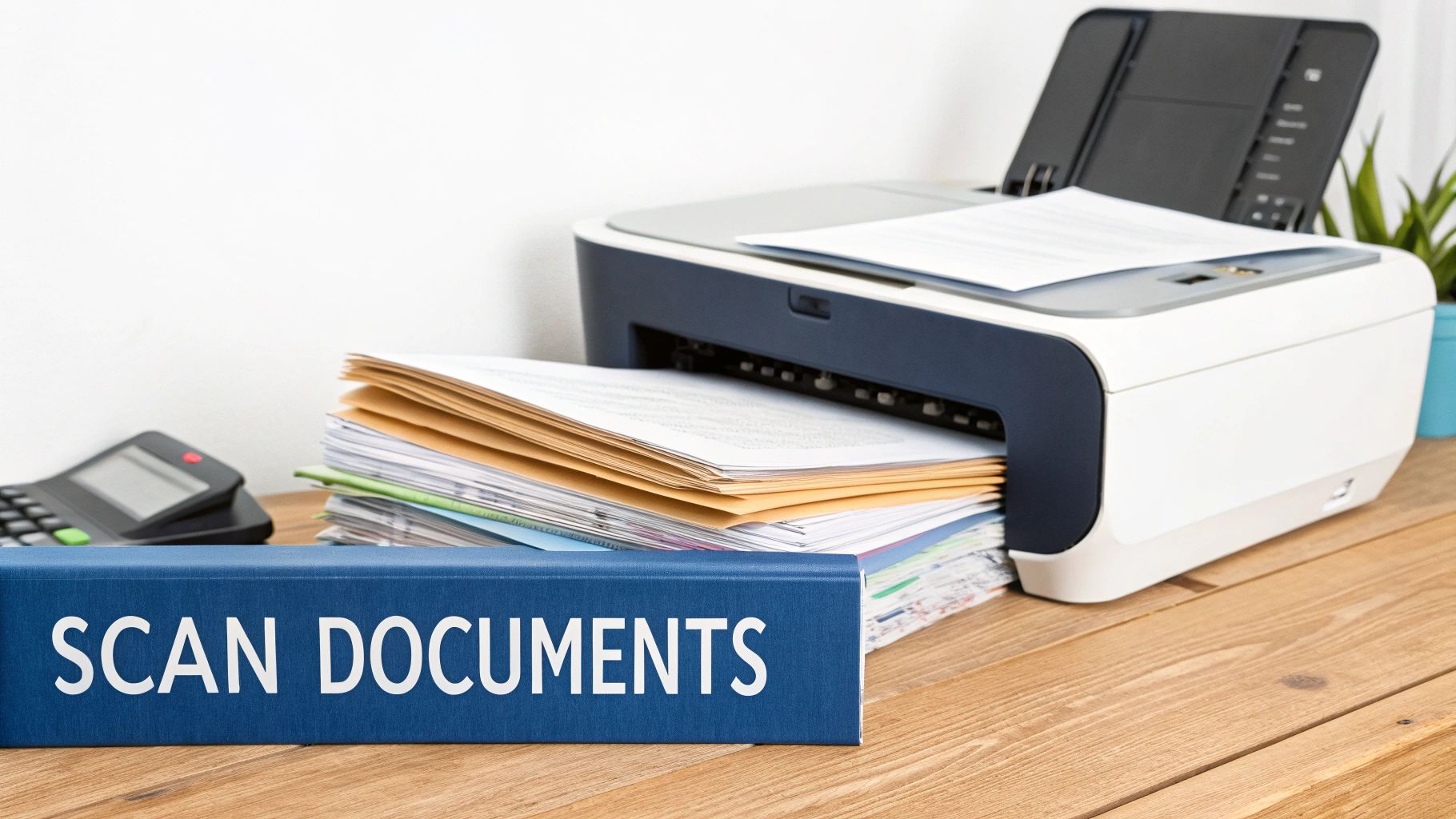Transform Your Business with Document Workflow Management
The Hidden Power of Document Workflow Management

Many businesses grapple with inefficient document handling, often unaware of the true scope of the issue. Document Workflow Management (DWM) offers a solution by structuring how documents are created, reviewed, approved, and stored. This goes beyond simply using shared drives or basic cloud storage.
Instead of disorganized chaos, DWM establishes clear processes for document management. This structured approach offers significant advantages.
Consider a purchase order requiring multiple approvals. With DWM, the document automatically routes itself to each necessary person, eliminating manual emails and follow-ups. This reduces delays and ensures accountability.
Version control, a key DWM feature, keeps everyone working with the most current document version, preventing costly errors. This organized flow transforms document handling into a well-oiled machine. These improvements are particularly beneficial for sectors with strict compliance requirements, like legal and healthcare.
The importance of DWM is underscored by the significant time wasted searching for documents. Studies reveal employees spend approximately 30% of their time looking for information. Furthermore, inadequate document management contributes to a 21.3% productivity loss.
This translates to substantial financial losses. More detailed statistics can be found here: https://theecmconsultant.com/document-management-statistics/ This lost time could be reallocated to strategic tasks, boosting overall productivity and contributing to business success.
How DWM Supports Compliance and Speed
Leading organizations are prioritizing document workflow design, recognizing that effective DWM supports both compliance and speed. Properly implemented systems offer audit trails, ensuring accountability and adherence to regulations.
This doesn't necessitate sacrificing speed. By automating routing and approvals, DWM accelerates document turnaround times. This blend of compliance and efficiency is a primary driver for businesses adopting DWM solutions.
Transforming Document Chaos into Streamlined Pathways
Real-world examples showcase the impact of DWM. Businesses implementing these systems frequently observe dramatic reductions in approval times, sometimes from days to mere minutes. This increased efficiency has a ripple effect.
Bottlenecks disappear, team morale rises, and cost savings become tangible. By transforming document disarray into streamlined processes, DWM directly affects the bottom line, making it a vital investment for businesses of all sizes.
The Business-Changing Benefits You're Missing Out On

Document workflow management is more than just simple file retrieval. It offers a wealth of advantages that many organizations unfortunately overlook. It's about fundamentally changing how you operate to gain more efficiency, increase productivity, and ultimately, boost profits. These systems help companies in various industries, from legal to healthcare, see substantial improvements in their day-to-day operations.
Streamlining Approvals and Eliminating Bottlenecks
Imagine approvals that take minutes instead of days. For businesses using robust document workflow management, this is the reality. Automated routing eliminates the back-and-forth of long email chains, allowing employees to focus on more strategic initiatives.
This increased efficiency has a ripple effect on team morale. Removing frustrating bottlenecks reduces the burden of administrative tasks. Employees feel more empowered to make meaningful contributions, leading to a more positive and productive work environment.
Measurable Cost Savings and Increased Revenue
Automated routing isn't just about saving time; it also significantly reduces costs. By streamlining processes and minimizing manual work, organizations can achieve substantial operational savings, translating into higher profit margins and increased revenue.
Improved document accuracy is another key benefit. Fewer errors mean fewer costly mistakes that can negatively impact client relationships and the bottom line. This focus on accuracy contributes directly to higher profits and stronger client bonds.
The financial impact of document management is clear. In 2024, the document management systems market was valued at $7.16 billion** and is projected to reach **$24.91 billion by 2032. Currently, 77% of businesses are expanding their use of document management software. This impressive growth highlights the recognized value of these systems in driving both process efficiency and profitability. For more detailed statistics, check out this resource: Document Management Statistics.
Enhanced Collaboration and Decision Quality
Beyond the quantifiable benefits, document workflow management delivers significant qualitative advantages. Improved access to information promotes better collaboration between team members, both in the office and remotely. This easy access allows teams to make better-informed decisions, faster.
Effective version control ensures everyone works with the most up-to-date documents, leading to better decisions and successful project outcomes. Clear access to the latest information facilitates more effective decision-making across the board. For further insights, read: Game-Changing Workflow Automation Benefits Business Success. This article delves deeper into how automation can transform your business.
To further illustrate the return on investment (ROI) of document workflow management systems, let's look at some key metrics. The following table presents average improvements and typical implementation timeframes.
Document Workflow Management ROI Metrics
| Metric | Average Improvement | Implementation Timeframe |
|---|---|---|
| Document Retrieval Time | 60% | 3-6 Months |
| Approval Cycle Time | 80% | 2-4 Months |
| Error Rate | 40% | 6-12 Months |
| Storage Costs | 25% | 1-2 Years |
| Employee Productivity | 30% | 6-12 Months |
This table showcases the potential for significant improvements across several key areas. While implementation timeframes can vary, the return on investment in terms of efficiency, cost savings, and productivity gains is substantial. Investing in document workflow management is a strategic move towards a more efficient and profitable future.
Must-Have Features That Actually Drive Results

Not all document workflow management systems are created equal. This section explores the features that genuinely enhance your operations, moving beyond marketing hype. We'll delve into how the right features can elevate collaboration, bolster security, and increase overall efficiency.
Intelligent Routing and Version Control
Intelligent routing is a key feature in modern document management. It acts as an automated system, directing documents to the correct individuals at the appropriate time. This eliminates delays associated with traditional email chains and drastically reduces approval times. This allows teams to dedicate more time to strategic initiatives.
Version control is another vital component. This feature ensures everyone works from the most recent document version. This prevents errors caused by using outdated information, which is especially critical for client-facing materials. For instance, a legal team working on a contract benefits significantly from version control. It guarantees everyone accesses the latest revisions, minimizing confusion and avoiding potential legal issues.
Robust Security and Mobile Accessibility
Security is paramount when handling sensitive information. A robust document workflow management system should offer features like access controls, encryption, and audit trails. These features safeguard sensitive data without impeding access for authorized personnel.
For example, in healthcare, access to patient records can be limited based on roles. This ensures compliance while simultaneously facilitating efficient collaboration amongst medical staff. Authorized personnel gain seamless access to necessary files, maintaining both security and operational efficiency.
Mobile accessibility is also indispensable in today's dynamic work environment. The ability to access and approve documents from any location and device empowers remote teams and field workers, creating greater flexibility and responsiveness. For more insights, check out this helpful resource: How to master document management.
Seamless Integrations and Smart Automation
Integration capabilities are essential. The system should integrate seamlessly with other core business applications like CRM and ERP systems.
This creates a unified information environment, breaking down data silos, and enhancing overall workflow efficiency. Integrating with a CRM, for instance, can automatically link documents to customer records. This provides a holistic view of client interactions, enhancing customer service, and streamlining data management.
Beyond integrations, smart automation features like automated notifications and task assignments are critical for maintaining smooth workflows. These features minimize manual intervention, reducing errors, and improving overall efficiency. By automatically reminding stakeholders of their duties and deadlines, these features help ensure timely completion of tasks. Through these essential features, document workflow management systems transform document handling, resulting in more efficient, secure, and ultimately, more profitable operations. They facilitate better collaboration, strengthen security, and drive significant operational improvements.
Overcoming Workflow Roadblocks Before They Stop You

Implementing document workflow management isn't always easy. Even with the best laid plans, organizations often encounter common challenges. This section helps you navigate these obstacles and ensure successful document workflow implementation.
Addressing Resistance To Change
One of the biggest hurdles is resistance to change. Employees used to established document habits may hesitate to adopt new systems. This reluctance can come from fear of the unknown or skepticism about the promised benefits. For example, some might worry about learning new software like Microsoft SharePoint or losing control over familiar processes. Addressing these concerns directly is crucial.
Open communication and thorough training are key. Clearly explaining the reasons for the change, highlighting its positive impact on daily tasks, and providing ample support can ease the transition. Involving employees early, soliciting feedback, and addressing anxieties fosters buy-in. This collaborative approach makes implementation smoother. Learn more about change management.
Integrating With Legacy Systems
Integrating document workflow management with existing legacy systems is another common challenge. Older systems are often inflexible and difficult to change, creating integration headaches. Extensive customization can be costly and time-consuming. Finding a balance between integration and customization is essential for success.
Prioritizing essential integrations is key. Focus on connecting systems that directly impact document workflows, like CRM or ERP software. For less critical systems, consider alternatives like data migration or manual data entry to minimize customization expenses. This focused approach ensures a cost-effective integration process.
Managing Diverse Departmental Needs
Different departments have unique document workflow requirements. Sales teams might prioritize quick access to client proposals, while legal teams emphasize strict version control and security. A one-size-fits-all approach is rarely effective.
Tailoring the system to meet specific departmental needs is essential. This might involve configuring custom workflows, setting different access permissions, or providing specialized training. This ensures each department benefits fully from the system while addressing its unique requirements.
To help illustrate these challenges and their solutions, let's look at the following comparison table:
Document Workflow Challenges Comparison
| Challenge | Small Business Impact | Enterprise Impact | Solution Approaches |
|---|---|---|---|
| Resistance to Change | Slow adoption, decreased productivity | Large-scale disruption, implementation delays | Training programs, change management communication, early involvement of employees |
| Legacy System Integration | Limited functionality, data silos | Complex integration, high customization costs | Prioritized integrations, data migration strategies, exploring alternative solutions for less critical systems |
| Diverse Departmental Needs | Inconsistent workflows, user frustration | Scalability issues, security risks | Customizable workflows, role-based access controls, tailored training programs |
This table highlights the varying impact of common document workflow challenges and offers practical solution approaches. By understanding these challenges and proactively addressing them, organizations can ensure a smoother, more successful implementation.
Your Document Workflow Transformation Blueprint
Implementing effective document workflow management requires a strategic approach. This blueprint provides a practical roadmap for optimizing your document processes, guiding you through assessing your current situation, identifying bottlenecks, and securing stakeholder buy-in for a smoother, more efficient implementation.
Assessing Your Current Document Reality
Before making any changes, it's essential to have a clear picture of your existing document workflow. This involves a thorough evaluation of your current processes. Identify pain points and quantify their impact on the business. For example, track the time it takes to process documents like contracts or invoices. Analyze the number of steps involved, pinpoint delays, and calculate associated costs. This assessment provides a valuable baseline for measuring future improvements and justifying the need for change.
Identifying Key Bottlenecks
Once you understand your current document processes, the next step is to pinpoint the most significant bottlenecks. These are the areas causing the most delays, errors, and frustration. Prioritize bottlenecks that impact core business functions or lead to significant financial losses. For instance, a slow invoice approval process can delay payments and negatively affect supplier relationships. Addressing these critical bottlenecks first delivers the greatest return on investment.
Building Stakeholder Support
Transforming document workflows requires buy-in from everyone involved, including leadership and employees who use the system daily. Building this support relies on clear communication and collaboration. Present your assessment findings clearly, highlighting the potential benefits of improved document workflow management. Focus on how these changes will positively impact daily tasks and the organization as a whole. Addressing concerns upfront and involving stakeholders in the planning process fosters ownership and increases the likelihood of successful adoption.
Creating Meaningful Implementation Phases
A phased approach to implementing document workflow management is recommended. Focus on achieving quick wins to build momentum. Start with a pilot project targeting a specific bottleneck. Automating a single approval process, for example, can demonstrate the system's value without overwhelming users. This initial success builds confidence and encourages wider adoption. Subsequent phases can then address further bottlenecks, expanding the system's functionality and integrating it with more departments.
Measuring and Tracking Improvements
Establish clear metrics to measure progress and demonstrate the value of your document workflow management system. Track key performance indicators (KPIs) such as document processing time, error rates, and storage costs. Regularly monitor these KPIs and communicate progress to leadership. This data showcases the system's positive impact and justifies continued investment. It also helps identify areas for further refinement and optimization.
Training and Change Management
Comprehensive training programs are vital for user adoption. Provide clear, concise training materials and ongoing support. Address not only the "how-to" aspects of the new system, but also the "why" behind the change. This deeper understanding fosters buy-in and promotes correct system usage. Effective change management techniques are also essential for overcoming resistance to new processes. Open communication, user feedback, and celebrating early successes contribute to a positive environment for adoption, ensuring a smooth transition and maximizing the benefits of your document workflow management transformation.
The Future of Document Workflow You Need to Prepare For
The document landscape is evolving, affecting how businesses function. Organizations must adapt to new technologies and document management strategies. This section explores emerging trends and how to prepare your business for future success.
AI-Powered Document Intelligence
Artificial intelligence (AI) is reshaping document workflow management. AI algorithms can automatically extract data, classify documents, and even generate predictions. This significantly reduces processing time and minimizes errors for tasks like contract or invoice processing.
This is the power of AI-driven document intelligence. For instance, AI can identify key clauses in a contract, automatically route it for approval based on content, and even flag potential legal issues. This streamlines contract review, strengthens compliance, and accelerates the entire process.
Blockchain for Document Authenticity
Blockchain technology provides a secure method for verifying the authenticity and integrity of documents. This is particularly beneficial for contracts, legal records, and other sensitive data. A blockchain creates a permanent, tamper-proof record of a document's history.
Any alteration attempts become immediately evident, fostering trust and security in document handling. While still in its early stages, blockchain's potential to transform document workflow management is immense, promising to reshape compliance and mitigate fraud.
Mobile-First Document Workflows
With the increasing prevalence of remote and hybrid work models, mobile-first document workflows are crucial. Employees require access to review and approve documents from any device, regardless of location.
Systems must be designed with mobile users in mind. Consider a field worker accessing the latest blueprints on-site or a sales representative approving a contract on a tablet. Mobile-first workflows empower employees, enhance responsiveness, and improve customer experiences.
Sustainable Document Practices
Businesses are increasingly prioritizing sustainability, which extends to document management. Reducing paper consumption, implementing digital workflows, and utilizing eco-friendly storage solutions are essential.
These practices not only benefit the environment but also contribute to cost reduction. Digital document management eliminates physical storage needs, reduces paper and printing costs, and simplifies document retrieval, leading to significant long-term savings.
Preparing for these trends is essential for maintaining a competitive edge. By embracing AI, blockchain, mobile technology, and sustainable practices, businesses can optimize their document workflows, minimize expenses, and improve overall performance.
Ready to experience the future of document workflow management? Discover how Whisperit can transform your business with its AI-powered dictation, transcription, and editing platform. Visit Whisperit today to learn more.